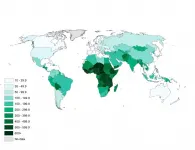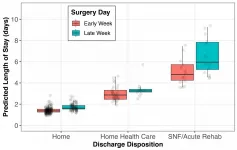Transportation noise pollution and cardio- and cerebrovascular disease
2021-04-06
(Press-News.org) Epidemiological studies have found that transportation noise increases the risk of cardiovascular morbidity and mortality, with high-quality evidence for ischaemic heart disease. According to the WHO, ?1.6 million healthy life-years are lost annually from traffic-related noise in Western Europe. Traffic noise at night causes fragmentation and shortening of sleep, elevation of stress hormone levels, and increased oxidative stress in the vasculature and the brain. These factors can promote vascular dysfunction, inflammation and hypertension, thereby elevating the risk of cardiovascular disease. In this Review, the authors such as Mette Sørensen from the Danish Cancer Society, Copenhagen, Denmark and the Department of Natural Science and Environment, Roskilde University, Denmark as well as Thomas Münzel MD and Andreas Daiber PhD from the University Medical Center Mainz at the Johannes Gutenberg University, Mainz Germany focus on the indirect, non-auditory cardiovascular health effects of transportation noise. They provide an updated overview of epidemiological research on the effects of transportation noise on cardiovascular risk factors and disease, discuss the mechanistic insights from the latest clinical and experimental studies, and propose new risk markers to address noise-induced cardiovascular effects in the general population. The authors also explain, in detail, the potential effects of noise on alterations of gene networks, epigenetic pathways, gut microbiota, circadian rhythm, signal transduction along the neuronal-cardiovascular axis, oxidative stress, inflammation and metabolism. Lastly, they describe current and future noise-mitigation strategies and evaluate the status of the existing evidence on noise as a cardiovascular risk factor.
Thomas Münzel, MD, lead author of the review and director of Cardiology at University Medical Center Mainz, Johannes Gutenberg University, Mainz, Germany, said, "as the percentage of the population exposed to detrimental levels of transportation noise will rise again when the COVID pandemic is over, noise mitigation efforts and legislation to reduce noise are highly important for future public health."
(DOI: 10.1038/s41569-021-00532-5)
INFORMATION:
ELSE PRESS RELEASES FROM THIS DATE:
2021-04-06
Humans have altered the ocean soundscape by drowning out natural noises relied upon by many marine animals, from shrimp to sharks.
Sound travels fast and far in water, and sea creatures use sound to communicate, navigate, hunt, hide and mate. Since the industrial revolution, humans have introduced their own underwater cacophony from shipping vessels, seismic surveys searching for oil and gas, sonar mapping of the ocean floor, coastal construction and wind farms. Global warming could further alter the ocean soundscape as the melting Arctic opens up more ...
2021-04-06
The world's first ground-based observations of the bare nucleus of a comet nearing the end of its active life revealed that the nucleus has a diameter of 800 meters and is covered with large grains of phyllosilicate; on Earth large grains of phyllosilicate are commonly available as talcum powder. This discovery provides clues to piece together the history of how this comet evolved into its current burnt-out state.
Comet nuclei are difficult to observe because when they enter the inner Solar System, where they are easy to observe from Earth, they heat up and release gas and dust which ...
2021-04-06
April 06, 2020-- A new commentary published online in the Annals of the American Thoracic Society provides an exhaustive examination of published research that discusses whether air pollution may be linked to worse COVID-19 outcomes. The studies that the authors examined look at several potential disease mechanisms, and also at the relationship between pollution, respiratory viruses and health disparities.
In "COVID-19 Pandemic: A Wake-Up Call for Clean Air," Stephen Andrew Mein, MD, Department of Medicine, Beth Israel Deaconess Medical Center, Boston, and colleagues ...
2021-04-06
A University of Guam review of published research on the critically endangered Serianthes nelsonii tree has revealed a reason why the population of the trees continues to be endangered despite a long history of funded conservation projects and a national recovery plan implemented 26 years ago. The review article, co-authored by biologists of the Plant Physiology Laboratory of UOG's Western Pacific Tropical Research Center, was published on March 2 in Horticulturae journal (doi:10.3390/horticulturae7030043).
"A main message of our paper is that decision-makers from funding agencies limit conservation success when practitioners ...
2021-04-06
A revolutionary technology developed within the END ...
2021-04-06
WASHINGTON, April 6, 2021 -- Home brewing enthusiasts and major manufacturers alike experience the same result of the beer-making process: mounds of leftover grain. Once all the flavor has been extracted from barley and other grains, what's left is a protein- and fiber-rich powder that is typically used in cattle feed or put in landfills. Today, scientists report a new way to extract the protein and fiber from brewer's spent grain and use it to create new types of protein sources, biofuels and more.
The researchers will present their results today at the spring meeting of the American Chemical Society (ACS). ACS Spring 2021 is being held online April 5-30. Live sessions will be hosted April 5-16, ...
2021-04-06
By 2050 global warming could reduce crop yields by one-third. UC Riverside researchers have identified a gene that could put the genie back in the bottle.
Warmer temperatures signal to plants that summer is coming. Anticipating less water, they flower early then lack the energy to produce more seeds, so crop yields are lower. This is problematic as the world's population is expected to balloon to 10 billion, with much less food to eat.
"We need plants that can endure warmer temperatures, have a longer time to flower and a longer growth period," said UCR botany and plant sciences professor ...
2021-04-06
DALLAS, April 6, 2021 -- A tsunami of chronic health conditions as a result of the SARS-CoV-2 pandemic, especially cardiometabolic disease, may produce an enormous wave of death and disability that demands immediate, comprehensive strategies. In addition, COVID-19 has disrupted cardiovascular science and medicine, yet it presents opportunities to transform and create novel approaches that can yield new successes. These are the opinions of two esteemed leaders in cardiovascular disease care, research and strategy, detailed in two new Frame of Reference articles published today in the American Heart Association's flagship journal Circulation.
While COVID-19 has severely impacted everyone's daily lives, its societal ...
2021-04-06
The inequality is enormous: Mothers in select African countries are more than 100 times more likely to have had a child die than mothers in high-income countries.
This is what Diego Alburez-Gutierrez (Researcher at the Max Planck Institute for Demographic Research (MPIDR) in Rostock, Germany), Emily Smith-Greenaway (Researcher at the USC Dornsife College of Letters, Arts and Sciences in Los Angeles and Guest Researcher at MPIDR), and co-authors found in their recent paper published in BMJ Global Health.
"We offer the first global estimates of the cumulative number of child deaths experienced by mothers ...
2021-04-06
CHARLOTTESVILLE, VA (APRIL 6, 2021). New research by a team from the Cleveland Clinic and the London School of Economics and Political Science (LSE) has determined that surgeries performed late in the workweek, and those culminating in discharge to a specialty care facility, are associated with higher costs and unnecessarily longer stays in the hospital following a common elective spine surgery.
Sebastian Salas-Vega, PhD, and colleagues retrospectively reviewed the data for all adult patients who underwent elective lumbar laminectomy over a nearly three-year period at any Ohio hospital included within ...
LAST 30 PRESS RELEASES:
[Press-News.org] Transportation noise pollution and cardio- and cerebrovascular disease







